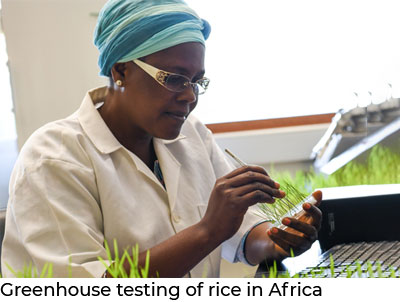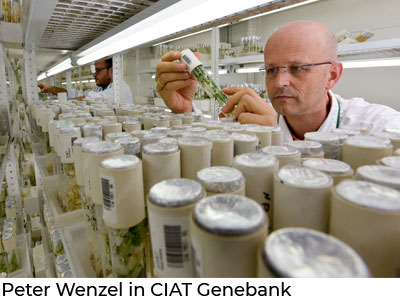Marcela Santaella’s highest priority is making sure that storage conditions are perfect at all times in the biggest genebank in Latin America. An overlooked temperature change of a few degrees can result in a loss of thousands of conserved seeds or plantlets.
“In the genebank, we work together every day to keep these crop seeds alive, for the well-being and food security of current and future generations,” said Santaella, who is the operations manager for the Alliance of Bioversity International and CIAT‘s genebank.
So what exactly are genebanks?
They are places where plants (as seeds or plantlets in test tubes) are stored for long-term conservation, catalogued, and made available for distribution for a variety of uses. Genebanks are essentially biodiversity repositories that also provide breeders and researchers with appropriate materials for genetic improvement and research.
Genebanks are also ‘’active’’—operations include growing accessions and collecting data on morphological, physiological, agronomic, and end-use quality attributes, adding value to accessions and facilitating their use. Any researcher in any part of the world may reach out to the nearest genebank and request seeds or planting materials; differently, farmers look for larger quantities of seeds of conventional varieties.
International & national genebanks
The Bioversity/CIAT genebank is one of 11 within the global CGIAR global agricultural research partnership, and it operates within the framework of the International Treaty on Plant Genetic Resources for Food and Agriculture (ITPGRFA). It is largely funded through the Genebank Platform coordinated by Crop Trust.
These 11 genebanks store more than 760,000 accessions of cereals, grain legumes, forages, tree species, root and tuber crops, and plantains and bananas. An accession is a distinct plant material from a single species which is collected along with other materials at one time from a specific location. These accessions attempt to capture the diversity present in a given population of plants.
The goal is to make this diversity available to breeders and researchers in a scientifically standardized, systematic, and cost effective manner while assuring long-term sustainability. Ease of access also encourages breeders to utilize genetic resources in their crop improvement programs. Over the past 10 years, CGIAR genebanks have distributed more than 1 million samples to plant breeders and crop researchers in more than 160 countries.
 Today, 1,750 genebanks in more than 100 countries house collections that contain more than 7.4 million accessions. This is especially important considering that in the last century, with intensification of agricultural production and its focus on more productive, input-responsive, and market-friendly varieties, most of these traditional varieties disappeared from farmers’ fields and markets, and now exist only as seeds and human heritage in gene bank collections.
Today, 1,750 genebanks in more than 100 countries house collections that contain more than 7.4 million accessions. This is especially important considering that in the last century, with intensification of agricultural production and its focus on more productive, input-responsive, and market-friendly varieties, most of these traditional varieties disappeared from farmers’ fields and markets, and now exist only as seeds and human heritage in gene bank collections.
One famous seed bank is located in Norway, within the Arctic Circle, called the Svalbard Global Seed Vault. It serves as a backup for the world’s genebanks. This international seed bank can hold a maximum of 2.5 billion seeds representing 4.5 million crop varieties (500 seeds from each crop). The Svalbard Global Seed Vault provides facilities for the safe deposit of seed samples that have distinct genetic resources of importance to food security and sustainable agriculture. It offers storage for duplicates of all unique seed accessions conserved by national, regional and international gene banks, research institutes and NGOs.
Genebanks vary greatly in terms of scope, specializing in one or in multiple crops, and storage capacity, from a few to hundreds of thousands of samples. The largest public genebanks are those established within the agricultural research institutes of the CGIAR such as the rice collection at the International Rice Research Institute (IRRI, Philippines) and wheat and maize at the International Centre for the Improvement of Wheat and Maize (CIMMYT, Mexico).
Significance of gene banks for biofortification
HarvestPlus works with CGIAR centers around the world to promote biofortified crops such as vitamin A cassava, maize, and sweet potato; iron beans and pearl millet; and zinc rice, maize, and wheat. Biofortification is the process of breeding staple crops to contain higher levels of micronutrients in order to help address micronutrient deficiency, or “hidden hunger.” The diversity of genetic plant materials in genebanks was essential to biofortification for most of the key food staples as genetic variation for micronutrients to reach nutritional targets was not present in breeding programs or in commercial varieties. HarvestPlus and its CGIAR partners, working with national authorities, have facilitated the release of more than 240 varieties of conventionally bred biofortified crop varieties, all of which relied on the genebanks. Adding other varieties of vitamin A orange sweet potato facilitated by the International Potato Center (CIP), the total number of biofortified varieties released so far comes to more than 370.
The process of biofortification begins by looking through these genetic “libraries” of thousands of seed varieties in CGIAR crop breeding centers around the world to identify naturally nutritious sources or accessions that are high in vitamin A, iron, or zinc, by shortlisting a core collection comprising of couple of thousand accessions. Plant breeders then cross these accessions with popular available varieties to develop high yield, micronutrient-dense varieties for Africa, Asia, and Latin America—a process that can take five to seven years. For example, for zinc-biofortified wheat, the breeders had to develop first parental lines through pre-breeding because the zinc trait donors with high zinc in the grain in the genebanks lacked the necessary yield or adaptability traits; this added significant time to the process of developing competitive varieties of zinc wheat.
Wolfgang Pfeiffer, HarvestPlus director of research and development, explained: “If suitable variation for micronutrients is present only in unadapted sources in the strategic gene pool, pre-breeding is necessary prior to using the trait in final product development, as the trait needs to be combined with commercially used genetic backgrounds.”
He added: “The difficulty in using unadapted sources in breeding increases with the genetic distance to modern varieties, and from the need to eliminate unfavorable traits during the selection process that the donor for micronutrient density carries. This adds to product development time and costs. [However], if adequate variation is present in the adapted gene pool, the trait donors can be used directly to develop competitive varieties.”
Once promising candidate varieties are identified in local testing, they are submitted to a country’s national agricultural research system (NARS), which then tests them for approximately two to three years (i.e., several planting seasons), with farmers providing input. NARS scientists ensure that the candidate varieties provide added value and have the trait package that makes them attractive and suitable for cultivation by farmers, including: yield per hectare; resistance to diseases, pests, and the effects of climate change; and the ability to grow in local soils, terrains, and micro-climates. The NARS then promotes “released” varieties with public- and private-sector partners, such as seed companies, NGOs, or civil society organizations.
The first crops developed and branded as biofortified were varieties of orange sweet potato with higher levels of provitamins A. High provitamins A concentration was discovered in screening and these varieties were introduced and tested as part of the process called the “fast track approach” in countries like China, Uganda, and Mozambique. Normally this approach is used when the breeders are aware of the possibility of improving nutritional status in local varieties. These biofortified varieties resulted from the partnership developed with CIP and released between 1993 and 1999 as commercial varieties. The first varieties of iron-biofortified beans were developed at CIAT, about seven years after crop development activities were first initiated through funding from HarvestPlus in 2003. Iron beans were approved by the Government of Rwanda for official release in 2010.
CIMMYT started the process of biofortification in wheat breeding in 2004. High micronutrient-carrying accessions of synthetic wheats, spelt wheats, and wheat landraces were crossed with high-yielding adapted bread wheats. This conventional breeding approach has resulted in the release of several varieties of wheat with high levels of zinc and high yields.
Crop varieties held in genebanks
The seed collection and storage process varies from one genebank to another. Generally, the process starts with researchers collecting seeds in nature, for example for wild relative species, or remote fields where farmers still grow and preserve old landrace varieties. Then researchers mark the relevant information of the site collected; this is pertinent for replanting or establishing local traits of the seed for replanting or breeding purposes. The sample seeds are given a unique identification number. Collectors clean each sample to ensure high quality, then reduce the moisture content of the seeds; they are dried in a temperature- and humidity-controlled room. Afterwards, they place the seeds in sealed, airtight containers. The final step is to freeze the seeds at minus 4 degrees Fahrenheit (minus 20 degrees Celsius) for storage.
The wheat holdings at CIMMYT comprise some 150,000 seed samples from more than 100 countries–the largest unified collection in the world for a single crop. CIMMYT’s maize bank contains 28,000 samples of seed, including the world’s largest collection of maize landraces—varieties developed by farmers over decades, centuries, or even millennia—along with samples of maize’s wild relatives, teosinte and Tripsacum, and of improved varieties.
Similarly, the International Center for Tropical Agriculture(CIAT) has been a leader in breeding beans that are productive and nutritious, housing almost 40,000 bean accessions, followed by the United States Department of Agriculture’s (USDA) Agriculture Research Service (ARS) genebanks with nearly 18,000 samples, and the Leibniz-Institut für Pflanzengenetik und Kulturpflanzenforschung (IPK) with more than 10,000 samples. Of the major food crops, beans, and especially common beans, show substantial variation. Growth habit, seed size, shape and color, days to maturity, cooking time (a gender-significant trait), and many other factors vary across varieties. There is hidden diversity too, not only in resistance to pests and diseases but also in the nutritional value of the seeds.
The largest cassava collections are held in vitro by CIAT with about 6,500 accessions, and by the International Institute of Tropical Agriculture (IITA) in Ibadan, Nigeria, with about 3,700 accessions. Research using some of these cassava varieties preserved in CIAT’s genebank has helped farmers improve yields and produce nutritious cassava roots with higher provitamin A content. There are more than 10,000 unique accessions conserved in the more than 70 cassava genebanks worldwide. In large areas of sub-Saharan Africa, and in parts of Latin America and southeast Asia, cassava provides a major daily source of dietary energy.
Genetically diverse materials stored in genebanks carry not only nutrition-smart but also climate-smart traits. These accessions have traits that can, for example, withstand increased flooding like the submergence-tolerant rice developed by IRRI. Genebanks are also pivotal in preserving genetic diversity that may otherwise be lost due to natural catastrophes or conflict. These events can wipe out seed stocks or leave farming communities in chaos. For example, an incidence of flooding or severe drought can decimate not only the current harvest but also the supply of available planting material for the next planting season.
With new emerging diseases and an increased prevalence of insects and pests, the germplasm from genebanks are a source of novel traits for everything from drought resistance to salt tolerance, to disease and pest resistance, and even serve as a key to help increase the nutrient content of roots and tubers. Research institutions use these materials to develop varieties that build farmers’ resilience to climate change and its impacts.
Future plans for genetically diverse crops
There is widespread recognition in the global community about the importance of protecting agricultural biodiversity. The United Nations Sustainable Development Goals (SDGs), specifically SDG 2 calls for securing crop diversity globally by the year 2020, as a prerequisite for food security and nutrition.
It states: “By 2020 maintain the genetic diversity of seeds, cultivated plants and farmed and domesticated animals and their related wild species, including through soundly managed and diversified seed and plant banks at the national, regional and international levels, and promote access to and fair and equitable sharing of benefits arising from the utilization of genetic resources and associated traditional knowledge, as internationally agreed.”
 Some of the genebanks are launching projects that will secure the future of agricultural diversity through innovations: for example, by launching “Future Seeds,” CIAT is tackling the challenges facing global crop diversity. Future Seeds builds upon the Center’s decades-long record of maintaining global collections of tens of thousands of varieties of beans, cassava and tropical forages. As a result of utilizing this repository of seeds, varieties which trace back to CIAT genebank parents are grown by vulnerable farmers around the world. As a genebank, it allows scientists to understand the hidden genetic traits of plants—many of which are now gone from farms and the wild.
Some of the genebanks are launching projects that will secure the future of agricultural diversity through innovations: for example, by launching “Future Seeds,” CIAT is tackling the challenges facing global crop diversity. Future Seeds builds upon the Center’s decades-long record of maintaining global collections of tens of thousands of varieties of beans, cassava and tropical forages. As a result of utilizing this repository of seeds, varieties which trace back to CIAT genebank parents are grown by vulnerable farmers around the world. As a genebank, it allows scientists to understand the hidden genetic traits of plants—many of which are now gone from farms and the wild.
“Working in a genebank, we continuously need to remind ourselves of our role as one of the guardians of the crop diversity that underpins food, agriculture and, ultimately, human civilization,” said Peter Wenzl, genetic resources manager at the CIAT genebank.
HarvestPlus and partners will continue to leverage genebanks to expand and improve the range of biofortified staple crop varieties available to farmers worldwide.
HarvestPlus works with the following CG Centers:
International Center for Agricultural Research in the Dry Areas (ICARDA), the Alliance of Bioversity International and CIAT, International Crops Research Institute for the Semi-Arid Tropics (ICRISAT), International Food Policy Research Institute (IFPRI), International Maize and Wheat Improvement Center (CIMMYT), International Potato Center (CIP), International Institute of Tropical Agriculture (IITA), and International Rice Research Institute (IRRI).
